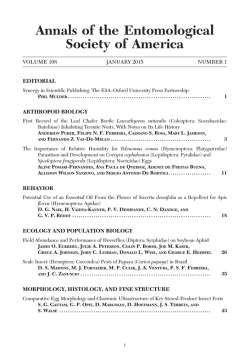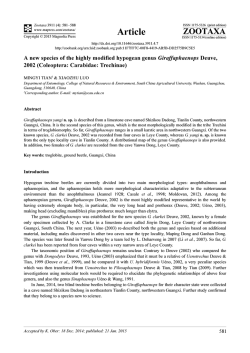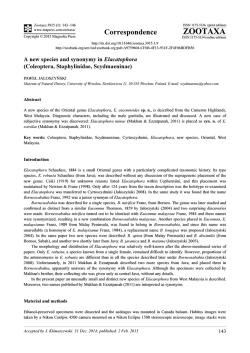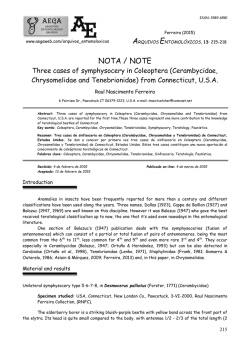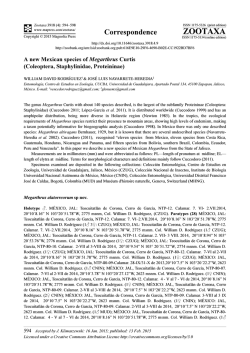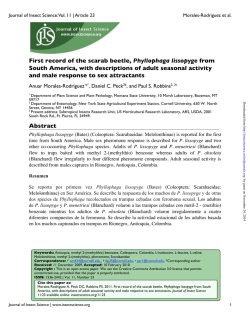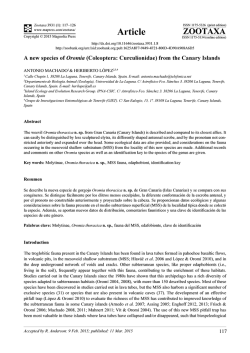
Preview - Magnolia Press
Zootaxa 3947 (4): 527–542 www.mapress.com /zootaxa / Copyright © 2015 Magnolia Press Article ISSN 1175-5326 (print edition) ZOOTAXA ISSN 1175-5334 (online edition) http://dx.doi.org/10.11646/zootaxa.3947.4.4 http://zoobank.org/urn:lsid:zoobank.org:pub:8FC05D43-724D-4A19-945F-6B5CE5DE2A0C A preliminary study on the phylogeny of the family Phengodidae (Insecta: Coleoptera) SANTIAGO ZARAGOZA-CABALLERO & MARTÍN LEONEL ZURITA-GARCÍA Departamento de Zoología, Instituto de Biología, Ciudad Universitaria, Universidad Nacional Autónoma de México, Apartado postal 70-153, C.P. 04510, México, D. F. México. E-mail: [email protected], [email protected] Abstract A morphology-based phylogenetic analysis of the family Phengodidae (Coleoptera) is given. Thirty-six terminals, six genera and 60 morphological characters are included. To test the monophyly of phengodid subfamilies the terminals that belong to superfamily Elateroidea Drilocephalus Pic (Dascillidae), Pterotus LeConte (incertae sedis), Vesperelater Costa (Elateridae), Photinus Laporte (Lampyridae), Pseudotelegeusis Wittmer and Telegeusis Horn (Telegeusidae) are used as outgroups, with the remaining 30 terminals corresponding to 26 specific and four generic levels. The matrix was analyzed under a parsimony criterion under a heuristic search performed in TNT v. 2.0. One parsimonious tree was obtained. In this study two principal groups are recognized in the family Phengodidae. This study suggests for the first time a close relationship between the Telegeusidae and the subfamily Penicillophorinae. Key words: Morphology, Bioluminescence, Elateroidea, relationships Resumen Se presenta un análisis filogenético morfológico preliminar de la familia Phengodidae (Coleoptera). Se incluyeron 36 terminales, seis géneros y 60 caracteres morfológicos. Para poner a prueba la monofilia de las subfamilias, se consideraron como grupo externo terminales de la superfamilia Elateroidea: Drilocephalus Pic (Dascillidae), Pterotus LeConte (incertae sedis), Vesperelater Costa (Elateridae), Photinus Laporte (Lampyridae), Pseudotelegeusis Wittmer y Telegeusis Horn (Telegeusidae), de los 30 restantes 26 están determinados a nivel específico y cuatro a nivel genérico. La matriz con 36 terminales fue analizada con base en el criterio de parsimonia con una búsqueda heurística en el programa TNT v. 2.0. Se obtuvo un solo árbol parsimonioso. En este trabajo se reconocen dos grandes grupos que integran a la familia Phengodidae. Este trabajo establece por primera vez una relación estrecha entre los Telegeusidae y la subfamilia Penicillophorinae. Palabras clave: Morfología, Bioluminiscencia, Elateroidea, relaciones Introduction The Phengodidae belong to the Elateroidea (Elateriformia), which includes Artematopodidae, Brachypsectridae, Cerophytidae, Eucnemidae, Throscidae, Elateridae, Plastoceridae, Drilidae, Omalisidae, Lycidae, Telegeusidae, Phengodidae, Lampyridae, Omethidae, Cantharidae, Podabrocephalidae and Rhinorhipidae (+Podabrocephalidae+Rhinorhipidae) (Lawrence & Newton 1995). Phengodidae were included in Cantharoidea by Crowson (1955, 1972) and Pototskaja (1983). Elateroids currently comprise 24,000 species included in 1,052 genera that are distributed throughout the world. Phengodids are restricted to the New World, from southern Canada to northern Chile-Argentina (Costa & Zaragoza-Caballero 2010). The Phengodinae includes four genera, two subgenera and 58 species, Mastinocerinae includes 25 genera, two subgenera and 199 species, and Penicillophorinae has five genera and six species. The most specious genera and subgenera are: Phengodes Hoffmansegg (s. str.) (9 spp.), Phengodes (Phengodella) Accepted by P. Johnson: 26 Mar. 2015; published: 17 Apr. 2015 527 The position of Cenophengus as sister group to the remaining mastinocerines and phengodines is need to be corroborated with an analysis that take a major sample of species and their monophyly has to be put to test. This genus has great plasticity, with their species displaying high variation in characters such as diameter of eyes, length and shape of antennae, elytral length and hind wing with elateroid venation or reduced and configuration of the radial cell. The 12-segmented antenna is common in the other genera, except 10 antennomeres in Decamastinocerus, and 11 antennomeres in Euryopa, Steneuryopa and Euryognathus species. The cylindrical or foliaceous shape of the antennal rami is shared with all genera (except the penicillophorines). Cenophengus species have two tentorial pits as Distremocephalus, Mastinocerus, Mastinowittmerus and Paraphrixotrix. Cenophengus and half of the remaining genera have labial palps with 2 palpomeres. The reduced antennal distance is shared only with Howdenia and Mastinomorphus. The tarsi without spines character is shared with Steneuryopa, Neophengus, Stenophixotrhix, Paraptorthodius, Spangleriella species and those of the genera of Phengodinae. Subfamily Phengodinae Phengodinae is recovered as non-monophyletic. The relationship between Pseudophengodes and Microphengodes was previously proposed (Wittmer 1976b). The species differ by the size of eyes, body length, apex of the last labial segment and last abdominal segments with or without luminous organs. Among all phengodids adults, Pseudophengodes have luminous organs only. Zarhipis differ from Phengodes by lacking sulci and antennal tubercles, eyes are reduced, elytra long, and tarsi lacking an aerolium. Given the results of this work we propose to re-circumscribe the Phengodidae (incl. Mastinocerinae and Phengodinae) as: antennal tubercles absent (3:1); antennae 12-segmented (10:0); third antennomere wider than long (16:0); galea developed (36:1); aedeagus with the flagellum visible (60:0). As final remarks we suggest a close relation of Telegeusidae with Phengodidae based on the present morphological analysis. The family Telegeusidae as new circumscribed include the genera Adendrocera, Acladocera, Pseudokarumia, Pseudotelegeusis, Tarsakanthus, Telegeusis and Walterius. So, the family Phengodidae is constituted by all genera included traditionally in the subfamilies Phengodinae and Mastinocerinae but in this work we do not propose any subfamilies for this new circumscription. Although supported by our results, the monophyly of these two principal clades still requires a more rigorous test that should include a major sample of terminals. Acknowledgments We are grateful to the curators of the collections mentioned in the materials and methods section for loaning the specimens used in this work. We greatly appreciate the revision and valuable comments by Dra. Helga Ochoterena, Dr. J. J. Morrone, Dr. Fernando Álvarez P. and Dr. Alejandro Zaldivar. We would like to thank Berenit Mendoza by take the photos of SEM and S. Guzmán (IBUNAM) for her help with the use of the Leica equipment. The second author is grateful for a doctoral and postdoctoral fellowship from the Consejo Nacional de Ciencia y Tecnología (CONACYT 164713, CONACYT 203807). References Barber, H.S. (1913) Observations on the life history of Micromalthus debilis LeC. (Coleoptera). Proceedings of the Entomological Society of Washington, 15, 31–38. Beutel, R.G. (1995) Phylogenetic analysis of Elateriformia (Coleoptera: Polyphaga) based on larval characters. Journal of Zoological Systematics and Evolutionary, 33, 145–171. Bocakova, M., Bocak, L., Hunt, T., Teraväinen, M. & Vogler, A.P. (2007) Molecular phylogenetics of Elateriformia (Coleoptera): evolution of bioluminescence and neoteny. Cladistics, 23, 477–496. http://dx.doi.org/10.1111/j.1096-0031.2007.00164.x Branham, M.A. & Wenzel, J.W. (2001) The evolution of bioluminescence in cantharoids (Coleoptera: Elateroidea). The Florida Entomologist, 84, 565–586. http://dx.doi.org/10.2307/3496389 540 · Zootaxa 3947 (4) © 2015 Magnolia Press ZARAGOZA-CABALLERO & ZURITA-GARCÍA Branham, M.A. & Wenzel, J.W. (2003) The evolution of photic behavior and the evolution of sexual communication in fireflies (Coleoptera: Lampyridae). Cladistics, 19, 1–22. http://dx.doi.org/10.1111/j.1096-0031.2003.tb00404.x Corel Corporation (2012) CorelDRAW Graphics Suite X6 (v16). Costa C, Vanin S. & Casari-Chen A. (1988) Larvas de Coleoptera do Brasil. São Paulo, Museu de Zoologia, Universidade de São Paulo, 282 pp. Costa, C. & Zaragoza-Caballero, S. (2010) Phengodidae LeConte, 1861. In: Richard, A., Leschen, B., Beutel, R.G. & Lawrence, J.F. (Eds.), Handbook of Zoology, Coleoptera, Beetles. Vol. 2: Morphology and Systematic (Elateroidea, Bostrichiformia, Cucujiformia partim). Walter de Gruyter GmbH & Co. KG, Berlin/New York, pp. 126–135. Crowson, R.A. (1955) The natural classification of the families of Coleoptera. Nathaniel Lloyd, London, 187 pp. Crowson, R.A. (1972) A review of the classification of Cantharoidea (Coleoptera), with the definition of two new families, Cneoglossidae and Omethidae. Revista de la Universidad de Madrid, 21, 35–77. Davis, J.I., Frohlich, M.W. & Soreng, R.J. (1993) Cladistic characters and cladogram stability. Systematic Botany, 18 (2), 188– 196. Goloboff, P.A. (1999) Analyzing large data sets in reasonable times: solutions for composite optima. Cladistics, 15 (4), 415– 428. http://dx.doi.org/10.1111/j.1096-0031.1999.tb00278.x Goloboff, P.A, Farris, J.S. & Nixon, K.C. (2003) T.N.T.: Tree Analysis Using New Technology. Program and documentation, available from the authors. Available from: http://www.zmuc.dk/public/phylogeny (accessed 31 March 2015) Horn, G.H. (1895) Coleoptera of Baja California (Supplement 1). Proceedings of the California Academy of Science, Series 2, 5, 242–243. Hunt, T., Bergsten, J., Levkanicova, Z., Papadopoulou, A., John, O. St., Wild, R., Hammond, P.M., Ahrens, D., Balke, M., Caterino, M.S., Gómez-Zurita, J., Ribera, I., Barraclough, T.G., Bocakova, M., Bocak, L. & Vogler, A.P. (2007) A comprehensive phylogeny of beetles reveals the evolutionary origins of a superradiation. Science, 318, 1913–1916. Ivie, M.A. (2002) The transfer of Pseudokarumia Pic from Dascillidae (Karumiinae) to Telegeusidae, with a key to world genera of Telegusidae. The Coleopterists Bulletin, 56, 582–584. http://dx.doi.org/10.1649/0010-065X(2002)056[0582:TTOPPF]2.0.CO;2 Jeng, M.-L. (2008) Comprehensive phylogenetics, systematics, and evolution of neoteny of Lampyridae (Insecta: Coleoptera). Phd Thesis, Graduate Faculty of the University of Kansas, 388 pp. King, E.W. (1955) The phylogenetic position of Atractocerus Palis. The Coleopterists Bulletin, 9, 65–74. Kundrata, R. & Bocak, L. (2011) The phylogeny and limits of Elateridae (Insecta, Coleoptera): is there a common tendency of click beetles to soft-bodiedness and neoteny? Zoologica Scripta, 40, 364–378. Kundrata, R., Bocakova, M. & Bocak, L. (2013) The phylogenetic position of Artematopodidae (Coleoptera: Elateroidea), with description of the first two Eurypogon species from China. Contribution to Zoology, 82 (4), 199–208. Kundrata, R., Bocakova, M. & Bocak, L. (2014) The comprehensive phylogeny of the superfamily Elateroidea (Coleoptera: Elateriformia). Molecular Phylogenetics and Evolution, 76, 162–171. Lawrence, J.F. (1987) Rhinorhipidae, a new beetle family from Australia, with comments on the phylogeny of the Elateriformia. Invertebrate Taxonomy, 2 (1), 1–53. Lawrence, J.F. & Newton, A.F., Jr. (1995) Families and subfamilies of Coleoptera (with selected genera, notes, references and data on family-group names). In: Pakaluk, J. & Slipinski, S.A. (Eds.), Biology, Phylogeny, and Classification of Coleoptera: Papers Celebrating the 80th Birthday of Roy A. Crowson. Museum i Instytut Zoologii PAN, Warszawa, pp. 779–1006. Lawrence, J.F., Hastings, A.M., Dallwitz, M.J., Paine, T.A. & Zurcher, E.J. (1999) Beetles of the world: a key and information system for families and subfamilies. CSIRO, Melbourne. CD-ROM version 1.0 for MS-Windows. Lawrence, J.F., Slipiński, A., Seago, A.E., Thayer, M.K., Newton, A.F. & Marvaldi, A.E. (2011) Phylogeny of the coleoptera based on morphological characters of adults and larvae. Annales Zoologici, 61 (1), 1–217. Leng, C.W. (1920) Catalogue of Coleoptera from America North of Mexico. John D. Sherman, Jr. Mount Vernon, New York, 470 pp. Martin, J.O. (1931) A new Telegeusis from Arizona (Coleoptera). The Pan-Pacific Entomologist, 8, 91–92. Miller, R.S. (2002) Family 68. Telegeusidae Leng 1920. In: Arnett, R.H., Thomas, M.C., Frank, J.H. & Skelley, P.E. (Eds.), American beetles. Vol. 2. CRC, Boca Raton, Florida, pp. 179–180. Nixon, K.C. (2002) WinClada ver. 1.00.08 Published by the author, Ithaca, NY. Paulus, F.H.F., von (1975) Penicillophorus ctenotarsus n. gen. et n. sp. aus kolumbien, mit einer beschreibung einer neuen tribus Penicillophorini der Phengodidae (Col., Polyphaga, Cantharoidea). Zeitschrift der Arbeitsgemeinschaft Österreichischer Entomologen, 25, 69–80. Pototskaja, V.A. (1983) Phylogenetic links and composition of the superfamily Cantharoidea(Coleoptera) based on the study of larval characters. Entomologicheskoe Obozrenie, 62, 549–554. Sagegami-Oba, R., Oba, Y. & Ohira, H. (2007) Phylogenetic relationships of click beetles (Coleoptera: Elateridae) inferred from 28S ribosomal DNA: insights into the evolution of bioluminescence in Elateridae. Molecular Phylogenetics and Evolution, 42, 410–421. Wittmer, W. (1976a) Eineneue Gattung der Familie Telegeusidae (Col.). Mitteilungen der Schweizerischen Entomologischen A PRELIMINARY STUDY ON PHENGODIDAE Zootaxa 3947 (4) © 2015 Magnolia Press · 541 Gesellschaft Lausanne, 49 (3–4), 293–296. Wittmer, W. (1976b) Arbeitenzueiner Revision der Familie Phengodidae (Coleoptera). Entomologische Arbeiten Museum G. Frey, 27, 415–524. Zaragoza-Caballero, S. (1990) La familia Phengodidae en los “Tuxtlas”, Veracruz, México. Anales Instituto de Biología Nacional Autónoma de México (Zoología), 61 (2), 307–312. Zaragoza-Caballero, S. & Pérez, C. (2014) Sinopsis de la familia Phengodidae (Coleoptera): trenecitos, glow-worms, railroadworms o besouros trem de ferro. Instituto de Biología, Universidad Nacional Autónoma de México, México, D.F., 127 pp. APPENDIX 1. Matrix of characters. Pterotus obscuripennis Photinus chamelensis Vesperelater occidentalis Drilocephalus pallidipennis Telegeusis chamelensis Pseudotelegeusis jiliotupaensis Zarhipis integripennis Phengodes atezcanus Pseudophengodes sp Microphengodes sp Distremocephalus wittmeri Cenophengus magnus Mastinowittmerus mexicanus Decamastinocerus parvimandibularis Euryopa singularis Ptorthodiellus trinidadicus Taximastinocerus brunneus Howdenia sp Phrixothrix tiemanni Paraphrixothris ecuadoranus Eurymastinocerus niger Cephalophrixothrix sp Ptorthodius mandibularis Mastinomorphus obscuripennis Mastinocerus germaini Nephromma barberi Oxymastinocerus unicolor Neophengus penai Stenophrixothrix pallens Parapthorthodius queretanus Spangleriella vittata Walterius caballeroae Tarsakanthus minuta Penicillophorus ctenotarsus Adendrocera flavulum Acladocera hispaniolae """""" " " " " " """"" """"" 542 · Zootaxa 3947 (4) © 2015 Magnolia Press ZARAGOZA-CABALLERO & ZURITA-GARCÍA
© Copyright 2025
